










































Jeff Editor editor@ quidsinmagazine.com
Through work, I talk to all kinds of people. Half provide services they say are designed to help people on low incomes. They don’t understand why people don’t attend appointments, take up offers of support, or join programmes to help them find work. I explain, sometimes nothing else matters when you can’t keep food on the table.
The other half I speak to are people whose money barely lasts from one month to the next. They attend Quids in! events, visit our drop-ins or come to us from landlords we work with around the country. We can run through a money healthcheck to see what they’re missing out on. But the first job has to be about food.
(68%) of people who were unable to work were most likely to miss out on meals. Our findings showed that the lower our income, the more likely we are to go hungry.
Quids in! is about helping people become better off. Not because we all want to be rich. It’s just no-one should be going hungry these days in the UK.
“Social tenants told us one in two of them (48%) were forced to skip meals”
This magazine is about all the tricks to avoid the need to skip meals to stretch a tight budget. Batch cooking means planning ahead to make two meals from one, for example. That can’t happen without an oven or a fridge or freezer to keep food in, so there are tips on this too.

In our 2022/23 Cost of Living survey, social tenants told us one in two of them (48%) were forced to skip meals. Worse, over two thirds
As with all Quids in! guides, this Food guide has been put together with feedback from readers across the UK. Let us know how you find it at quidsin@cleanslateltd.co.uk
• Address 14 St James’s Parade, Bath, BA1 1UL Tel 0845 646 0469
• Editor Jeff Mitchell Email editor@quidsinmagazine.com
• Design Joe Burt Website wildsparkdesign.com

• Head of Business Development Lisa Woodman Email lisa.woodman@cleanslateltd.co.uk
• Contributors Maggy Owen and Madeleine Caravaggio Email quidsin@cleanslateltd.co.uk
• Office Manager Dan Fineman Email daniel.fineman@cleanslateltd.co.uk
© This magazine may not be reproduced in part or full without prior written permission The publisher (Clean Slate Training & Employment CIC) makes every effort to ensure content is correct at the time of going to print. We have no political allegiances, and opinions expressed are not necessarily those of the publisher or editor. Any relationship with advertisers or sponsors is always on the understanding that we retain our editorial independence.


Our purpose

If you’re struggling to put food on the table, you’re not the only one.
According to the latest figures released in June, around 10 million people, including over 2 million children in Northern Ireland, Wales and England have been forced to skip a meal or cut down on food.
According to the Food Foundation’s Policy and Advocacy Manager Shona Goudie, the recent announcement that the Government is forming a Child Poverty Action Taskforce to help tackle the issue “is a positive step”.
She added: “Food insecurity has been persistently far too high over the last few years with the previous government failing to take decisive action for too long”.
As the cost of living continues to rise, visits to food banks have also been increasing
with the four top reasons being down to ‘low income’, ‘benefit delays’, ‘benefit changes’ and ‘debt’.
And it’s not just food banks that are on the rise. More children are being signed up for free school meals by their parents or carers. Free school meals ensure that children get a healthy meal at lunch time and a plus side is their school, for each child signing up, gains extra funding from the government.
Information on claiming free school meals can be found on local council websites.
“Food insecurity has been persistently far too high over the last few years”
You can follow up what you read in Quids in! by turning to the internet. Simply type the qimag.uk/link (as it appears in the story) into the web address bar on your browser and press 'enter'. Check out our Animal Antics playlist at qimag.uk/qianimals
Food banks and community kitchens run off volunteers. Why not help? You can commit to as little or as much time as you have available – it all counts. Training will normally be provided. Here are 5 roles you can expect to find:
1
Become a food packer or a warehouse volunteer
Help is needed to sort through donations and pack essential food items into parcels. Food banks operate on a shift basis.
2
Become a delivery driver
Food needs to be delivered to the most vulnerable. For this role we must have access to a car and a valid drivers licence and be DBS checked.

Community kitchen volunteer
Community kitchens need us to get stuck in with prepping meals and cleaning up.
4
Signposts
Food banks need volunteers to support guests accessing help from other vital services. We will receive training on how to have sensitive conversations and record information.
5
Telephone volunteers
People get referred to a Food Bank by health professionals or other public bodies. We might be able to take phone calls from donors, members of the public and guests.
Look on your local food bank’s website or call Citizen’s Advice on 0808 208 2138 to find your nearest one.
Here in the UK we are eating a lot less meat than we did a year ago. Once seen as a ‘fad’, plant-based diets are becoming more popular. So much so that the number of vegans in the UK has gone up four times since 2014. There has also been a huge rise in supermarkets stocking meat and dairy-free products. And sales of eggs have gone through the roof as more of us look for cheaper, meat-free protein options. Not only is it cheaper but it’s better for us,

too. Even some of the top footballers such as Lionel Messi are getting in on it. For some ideas to get you started, check out our recipe section on page 12. We can switch meat for a veggie alternative in almost every meal. Try swapping chicken for jackfruit, aubergine or meaty mushrooms. Pulses like lentils or beans are cheap and filling.
1659850378 or call
£858
The amount more than half of households on a trial saved per year when they cut back on their food waste
76KG
Weight of food each household was throwing out per year before the trial
94%
Number of households that carried on their good habits after the trial ended
Trial organised by Tesco and the environmental charity Hubbub.

Cooking in bulk saves us time and money, and it means there’s always something decent to put on the table…
Someone who has made a career out of cooking now and saving for later is Suzanne Mullholland, also known as ‘The Batch Lady’. It’s fair to say Suzanne has turned cooking in bulk into an art form. With a huge internet fan base and a cookbook to boot, she’s riding the crest of the bulk cooking wave.
Suzanne can cook forty meals in an hour, and can make ten different meals from a handful of ingredients, using just a spoon! The cover of her book has a simple message: ‘Shop Once. Cook Once. Eat Well All Week.’
We don’t all need to take it as far as Suzanne, but her success shows how popular cooking in bulk is. And if we follow her message, we’ll be quids in and time rich. So what are the steps to taking back control of our time in the kitchen and the money in our pocket?
Cooking in bulk begins with planning meals. We’ve published an article on how it is possible to do an entire weekly food shop for £10 (quidsinmagazine.com/blogpost/cheap-eats/). It goes to show that planning saves pounds. Using a site like mysupermarket.co.uk is great to work out how much we need to spend.
Things like stews, curries and pasta sauces are cheap and easy to stretch out,

and they freeze well too. Home cooked food almost always has less fat and salt used in it, so it’s much better for our health, too.
Generally, the cost of food goes down as the size and weight goes up. For example, 500 grams of minced beef will cost more per gram than 1,000 grams. So, if you’ve got the storage space and the cash, consider buying bigger at the supermarket. Another knockon benefit of buying in bulk is it usually means you get less packaging, which is also good for the environment.
“Take back control of your time in the kitchen and your money”
It doesn’t matter if we live on our own or have a big family, cooking in bulk saves so much time. Scaling up a recipe to make ten portions instead of two might take a few more minutes in prep time, but if it takes an hour to make 10 portions, compared to 45 minutes to make two, we’ve saved nearly
three hours. Plus, our energy bills will come down as we are using less.
Once you’ve done the hard work and cooked a big batch of tasty grub, all you need to do is pop it into freezable containers and label them. Most meals can be frozen for up to six months, so it’s important to write a date so you know how long it’s been in there. When you’re ready to eat it, simply reheat in the microwave or on the stove. Remember to follow reheating guidelines.

There are a few things we can bear in mind to really bring down our food costs.
✔ Veg is cheaper than meat, so go veggie for a couple of meals and save some cash
✔ Cooking in batches saves us time and money
✔ Bulk out meals with the cheaper stuff
✔ Dishes based around rice, pasta or couscous go a long way
✔ Don’t forget about nutrition – again, veg is cheap, so try and get as much as possible

≠ ALWAYS USE A SHOPPING LIST: Supermarkets are designed to make us spend as much money as possible. The store layout, branding and special offers are all carefully considered to make us splash out. By making sure we go in armed with a shopping list and working out exactly what we need before we step inside, we’re more likely to avoid making impulse buys.
≠ PAY IN CASH: Using a credit or debit card makes us more likely to overspend. Allocating a weekly budget and taking the exact amount with us when we go to the supermarket means we can’t go overboard. If we do our shop online, there is a running total to help keep us on track.
≠ SWITCH DOWN WHERE POSSIBLE – AVOID THE BIG BRANDS: Often supermarket own-brands and ‘value’ versions are the same quality as the bigger brands. The only reason they cost less is because they spend less on advertising and packaging. Try out the cheaper brands and judge for yourself.
≠ FOR BEST VALUE ALWAYS GO BY ‘UNIT PRICE’: To really find the cheapest option, look at the ‘unit price’, which is usually written underneath the actual cost of the item. For example, if one 100g jar of jam costs £1, it is more expensive than a 200g jar of jam that costs £1.50.
Millions of us are living without essential household items such as a fridge freezer or cooker
Savvy Quids in! readers often remind us it’s cheaper and healthier to cook food from scratch. We can save money buying and cooking in bulk too, stocking up on home-cooked ready meals for the next few days. It also costs less (and saves time) to wash our clothes at home rather than using a laundrette.
But we can’t do any of this if we don’t have our own oven, fridge, freezer or washing machine. And that’s the situation for 4.8 million households in the UK.
Luckily, if we are struggling to buy white goods, there is help available.
The charity Turn2Us has a search tool on its website that directs householders to financial help. It asks for our age, gender, health status, nationality, location and the jobs we’ve had. Often there’s a fund we can apply for.
If we have worked in construction, for example, B&CE’s Charitable Trust may be able to give us a hardship grant. There is financial support available for almost every profession, including hair and beauty, pubs and bars, and mechanics. It could be enough to fill a gap with a new cooker.



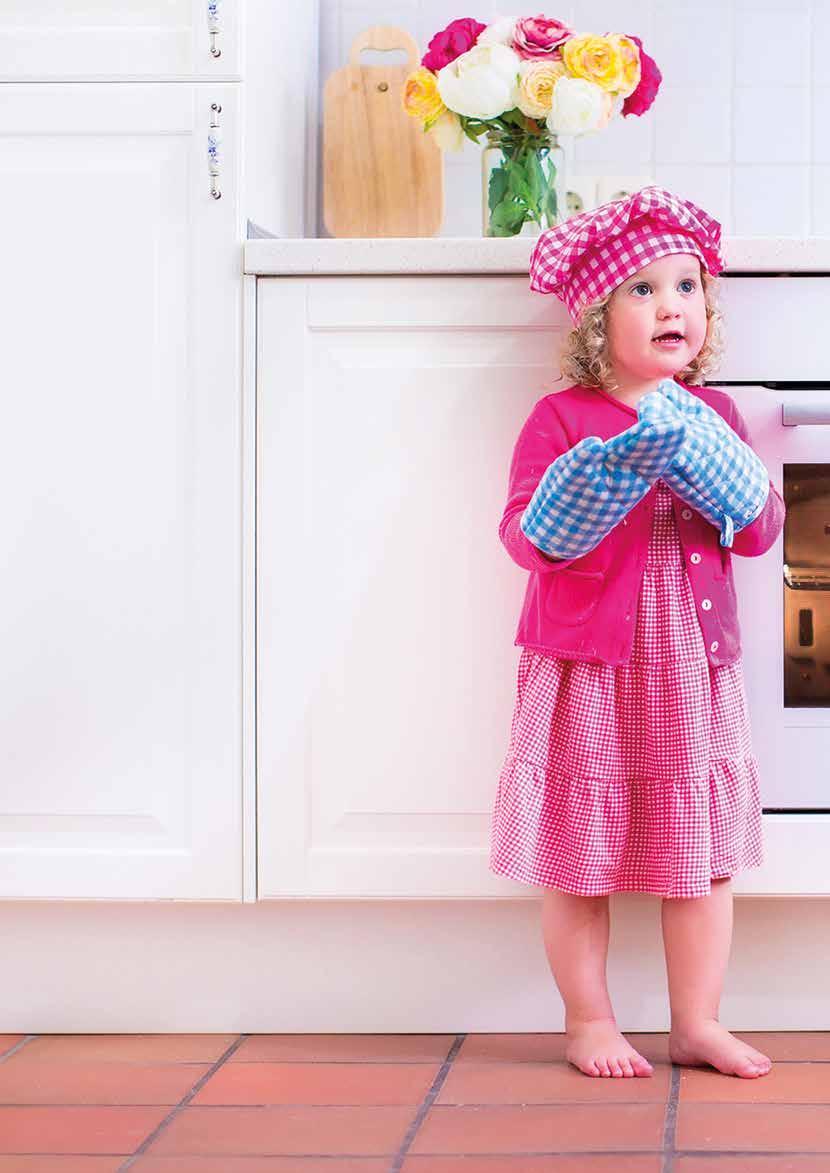
If we have disabled children, we can apply to the Family Fund. Or, if we, or a member of our family, suffer from mental health issues, there is another charity we can turn to. Same for those in recovery from substance misuse. Or people from a specific faith. Each one has its own ways of working out if it can help us.
Dawn Jackson, head of Grants at Turn2Us, says: “You can check if you’re eligible for support from over 1,500 grantgiving charities. These include charities who offer help with the cost of white goods (like ovens and fridges). Unlike loans, you don’t have to pay a penny back. Last year we awarded a total of £3.4 million in grants to over 2,500 recipients.”
As well as grants, it’s worth checking out websites where a range of household goods can be picked up for free or reduced prices. A few to try, where you can find people in your local area who are giving away unwanted items, include:
• Freecycle
• ilovefreegle.org
• gumtree.com.
Remember, there are no safety guarantees when picking up second-hand goods this way. At least check the plug is
“If we are struggling to buy white goods, there is help available”
properly wired and all of the cables are fully insulated before plugging it in. Any signs of overheating, like scorch marks, might suggest it’s not fit for use.
Furniture banks are popping up around the country too. They offer fridges and kitchen appliances at a heavily discounted price. It’s worth asking a local church or community centre or checking online. Our landlord or local council might also know if there’s help in the area.
There are furniture recycling projects all over the UK and many sell electrical items as well as sofas, tables and chairs. They don’t often provide goods for free but they are still way cheaper than buying new. To find out if there’s one nearby visit: qimag.uk/whitegoods. We can tick the box for electrical items to speed up the search for what we need.
For readers in Scotland, community care grants are available via the Scottish Welfare Fund, which is a national scheme delivered by local authorities. We can apply for the grant via our local authority. As well as using the grant to pay for a cooker, fridge, freezer or washing machine, it can be used to help with living expenses.
Welsh readers can apply to the Discretionary Assistance Fund (DAF), which offers grants to buy fridges, cookers and other household items.
Turn2us’ Dawn Jackson adds: “Basic household appliances are not a luxury. Living without a cooker, for example, takes away dignity, leaves families worse off, and the impact on children or other dependants cannot be overstated.
“Heather and David needed to move after David’s leg was amputated. Frequent trips to hospital meant they struggled to afford what they needed, including a cooker. By using our Grants Search, the couple were able to secure an Elizabeth Finn Fund grant to help.”
≠ Tenants who rent from the council or a housing association or charity should also speak to their landlords about any help available.



As the cost of living increases, making sure we have food in the cupboard is one less thing to worry about. Stashing an extra tin here, and an extra packet there when we shop means we can build a stockpile of food to ease pressure on our pockets until our next payday comes around.
It’s a dilemma many of us face every week: “What if our income dried up and all we could feed our families was what’s in the cupboards?”
Now, as millions of us face higher energy prices or are waiting for our Universal Credit to kick in, it’s a question everyone might be starting to ask themselves.

When Universal Credit was just starting and people waited weeks for their first Quids in! got to thinking. What if we all built our own foodbank? Now we’re revisiting the question.
Stockpiling is not only a way to save on food, it’s its own version of savings. Think about when we get our income. We might set aside a little cash while we have it so when times get tough, we have some reserves.
That’s what a Doomsday cupboard is. At the start of the month, or whenever we are paid, we buy all our food for the month. So if our income dries up, or an unexpected
bill comes our way, grocery shopping is one less expense to think about.
Non-perishables like tinned goods and frozen peas, or food that doesn’t spoil easily like potatoes are the best for stockpiling. See more of our tips on stockpiling.
As Quids in! would always say: Don’t fear the worst, just prepare for it. That’s why we call our personal little foodbank our Doomsday Cupboard! In our free download (seen below) we teamed up with the food kit people at Foodini Club back in 2018 to create a cheap and easy plan to build our own ‘Doomsday Cupboard’.
So whether we aim to save a month’s food costs, need to migrate to Universal Credit, or have to sit out an alien invasion, we’ll keep the family fed.





1 Stay healthy and buy a mix of dried long-life grains, tinned goods, frozen and fresh produce to maintain a mixed diet
2 Store everything carefully and buy the longest lasting goods first. If you don’t have a freezer, see if you can find help to get one (see pages 8-9)
3 Try different shops like Asian and wholesale stores that might sell by the sack (eg, potatoes, onions) or in multipacks
4 Shop around online to find the best deals
5 Invest £4-5 a week (£20 a month) for as long as it takes to have the essentials for a shopping-free month, cutting back on other things
6 Don’t forget toilet rolls
We also turned to money savvy members of SkintDad's Facebook group Reduce Your Supermarket Spend. How would they handle a month without shopping?
Jacqui K: Evaporated milk, dried milk, flour, rice, pasta, cheap tinned toms, soya mince, seeds to grow your own spinach (so easy to grow), sauces and gravy (makes spinach more edible!), oil, tinned meat. Buy a few extra items each week.

We’ve made it even easier for you by setting out a plan to go shop-free. We recommend starting right away and planning three months ahead but if it takes longer, that’s okay. Just stay alert for any warnings about lockdowns or food shortages.
Month One. (Three months prior to completing the Doomsday Cupboard):
• TINNED GOODS: Tomatoes (essential), pulses and beans (chickpeas, kidney and baked beans), sweetcorn, peas; also meats, tuna and soups
• OILS AND SPICES: Vegetable/olive oil, vinegar (for sauces and dressings), mustard, salt, pepper, stock cubes, spices and herbs that add useful extra flavour to repetitive meals. (For example, mince and tomatoes make a bolognese one day but add chilli and kidney beans and it’s a chilli the next!)
Month Two:
• DRIED GOODS: Pasta, dried beans/chickpeas (which you soak before cooking but are cheaper to buy), sacks of rice, couscous, lentils, tea/ coffee… and loo roll!!
• FLOURS AND SHORTER-LIFE DRIED GOODS: Flours, baking powder, sugar, milk powder and oats, which can be used for porridge, tasty flapjacks, or just bulking up veggie burgers and meatballs
Month Three:
• FROZEN (IF YOU HAVE A FREEZER): Peas, meat (mince, chicken breast portions, Quorn mince, fish pieces, spinach chunks – very useful for sauces and curries), frozen fruit/berries and fruit for freezing (like bananas)
• LONGER-LIFE FRESH PRODUCE: Squash/pumpkins, onions and potatoes, carrots and lemons. Buy these as close to the month ending as possible. Other fresh vegetables can be blanched in boiling water, then frozen in chunks to use through the month
Sam P: Pasta, rice, cereals, dried milk, sugar, tinned food, coffee, etc. Bread, cheese, meat in the freezer. Potatoes in garage. Also, plenty of toiletries and cleaning products. It would be doable



Sarah Ann G: Would make sure the freezer was completely full before the deadline! I have herbs and potatoes growing in the garden, so could make use of them, also have some seeds for other bits that I’d want to plant out to use.


N: I could probably feed us and next door as well without getting a single extra thing. It’s not called the Doomsday cupboard for nothing!

Chances are, we won’t need to raid our Doomsday Cupboard right away. Keep rotating the fresh produce, eating and replacing it before it goes out of date.


Vicky M: I could survive for the next 3 months on the food stock I have already in. All I need to do is kick out the 3 kids or move into my shed

Over the years, Quids in! has interviewed some famous chefs — and been given some great recipes to share along the way, this is a collection of the best of them. These recipes have a lot in common – they’re not difficult to make, they use cheap ingredients or leftovers, and they are all certified delicious. Our Hairy Biker’s recipe is our favourite page on our website, so we know that a good recipe goes down well with everyone.
Tomato Sauce pp12
White Sauce pp12
Hairy Biker’s Cottage Pie pp13
Hash Browns pp14
Cheesy Potato Bake pp14
Home-made Oven Chips pp14
Groundnut Turkey Stew pp14
Toad In The Mush pp15
Italian Style Pasta pp16
Coconut Dal pp16

Sweet and Sour Chicken pp17
Delicious Banana Loaf pp17
Chicken Tikka Masala pp18
Paneer Kofta pp18
West Indian Chicken Stew pp19
Ackee And Saltfish pp19
Banana Breakfast Cookies pp20
Cheesy Veggie Pasta pp20
Jack Monroe’s Chilli pp21
Golden Syrup Flapjacks pp23
Serves 2-4, Costs 60p
Asimple tomato sauce can be the basis of so much good food. And this one is easy, inexpensive and delicious. Put seafood in it and serve it over jacket potatoes. Add minced beef and red kidney beans and you’ve got chilli con carne. Blitz it to make the best-tasting pizza topping ever. And it’s even great, served just as it is, with some pasta and a sprinkle of cheese.
INGREDIENTS
• 1 400g Tin Chopped Tomatoes (or half a dozen chopped fresh ones)
• 1 tbsp oil
• 1 medium onion
• 1 carrot
• 1 garlic clove (optional)
• 1 chilli (optional)
• 1 bay leaf
• A pinch of sugar
• A teaspoon of vinegar
• A pinch of dried herbs
• Salt and pepper to taste
METHOD
1 Chop the onion and chilli, grate the carrot and crush the garlic. Put the oil in a frying pan over a medium heat. Add onion, bay leaf, carrot, garlic and chilli and fry until soft.
2 Add the tomatoes, herbs, sugar and vinegar and cook over a low heat with the lid off – the longer the better. Add water if needed, to keep it moist and stop it getting too thick.
3 Taste it, add salt and pepper. Remove the bay leaf. Serve.
Serves 2, Costs 85p
Learn to cook our second sauce and open up new possibilities. A white sauce can be the start of some magical food, especially when combined with our tomato sauce. Or add cheese for a cheese sauce, freshly-chopped parsley for a parsley sauce or fried mushrooms for a mushroom sauce, all are lush on a baked potato.
INGREDIENTS
• 500 ml whole milk
• 1 small carrot
• 1 medium onion
• 1 bay leaf
• 2 cloves
• 50g butter
• 50g flour
• Salt and pepper to taste
METHOD
1
Put the milk in a saucepan and add the carrot, bay leaf and onion studded with the cloves. Bring nearly to the boil and then leave to rest for 20 minutes or more.
2 In another saucepan heat the butter gently. When it’s melted add the flour and mix the paste well. Continue to cook gently for another couple of minutes to stop the final sauce tasting too much of flour.
3 Remove the bay leaf, carrot and onion from the milk. Slowly add the milk to the flour and butter mixture over a medium heat, stirring all the time. The sauce will thicken. Stop when it’s just about to boil. Season.
In the last edition of Quids In! we caught up with the new slimline Hairy Bikers. Sadly Dave Myers isn’t with us anymore but Si King is committed to carrying on their great work with the team.
It’s often called a ‘lightbulb’ moment. When something goes off in your head and you leap to a sudden realisation. For Si King and Dave Myers, aka The Hairy Bikers, their lightbulb moment came when they were on holiday together at Christmas…
“I’d run out of blood pressure pills,” says Dave, “and so I popped into Si’s room to try to nick some of his. And then I realised that it wasn’t really very rock and roll, both of us being on the same blood pressure pills. Maybe it was time we did something about it.”
It’s probably understandable that the Hairy Bikers had put on a lot of weight over the years. After all, they’ve been all over the world cooking and eating, with hardly a dull moment for the last ten years, and that sort of lifestyle takes its toll.
The challenge the Hairy Dieters set themselves was to lose weight, but without resorting to faddy foods or starving themselves. One of the first things that had to be tackled was the booze.
“Wine and beer are something I relied upon. I do drink less now –but I appreciate what I drink more,” says Dave.
And when it came to the food The Hairy Dieters still wanted to enjoy eating which is why they’ve come up with a range of healthier recipes like their Cottage Pie below.
And their dieting isn’t an obsession either as Si points out: “When we get to a point that’s healthy, we’ll start to eat pies again. Just not all the time.”
322 calories per portion (if serving 6)
Cottage pie is a hearty dish and one that we love to eat. Happily, this version is lower in calories than usual so we can continue to enjoy one of our favourite meals. Use lean beef, cook it without fat and bulk out the mash with leeks to reduce the calories. Serves 6–8
INGREDIENTS
• 400g lean minced beef
• 2 medium onions, chopped
• 2 celery sticks, finely sliced
• 2 medium carrots, diced
• 400g can of chopped tomatoes
• 2 tbsp tomato purée
• 500ml beef stock, made with
• 1 beef stock cube
• 1 tbsp Worcestershire sauce
• 1 tsp dried mixed herbs
• 4 tsp cornflour
• 1 tbsp cold water
• flaked sea salt
• freshly ground black pepper
Leeky potato topping
• 750g floury potatoes, such as King Edwards or Maris Pipers
• 2 tsp sunflower oil
• 2 slender leeks, trimmed and cut into 1cm slices
• 150g half-fat crème fraiche
• salt
• black pepper
1
242 calories per portion (if serving 8)
under £6!
3
Place a large non-stick saucepan or flameproof casserole dish over a medium heat. Add the mince and cook it with the onions, celery and carrots for 10 minutes until lightly coloured. Use a couple of wooden spoons to break up the meat as it cooks.
2
Stir in the tomatoes, tomato purée, beef stock, Worcestershire sauce and mixed herbs. Season with a good pinch of salt and plenty of freshly ground black pepper. Bring to the boil, then reduce the heat, cover loosely and simmer gently for 40 minutes, stirring occasionally until the mince is tender.
Now start the potato topping. Peel the potatoes and cut them into rough 4cm chunks. Put them in a large saucepan and cover with cold water. Bring to the boil, then turn down the heat and simmer for 18–20 minutes or until the potatoes are very tender. Heat the oil in a non-stick frying pan and fry the leeks for 5 minutes until softened but not coloured, stirring often. Drain the potatoes, then tip them back into the pan, season to taste and mash with the crème fraiche until smooth. Stir in the sautéed leeks and set aside.
4
Preheat the oven to 220°C/Gas 7. Mix the cornflour with the cold water to make a smooth paste. Stir into the simmered beef and cook for another minute or until the sauce is thickened, stirring often.

5



Pour the beef mixture into a 2-litre shallow ovenproof dish. Using a large spoon, top the beef with the mashed potatoes and leeks. Spoon the mixture all around the edge of the dish before heading into the middle, then fluff up with a fork.
6
Bake for 30 minutes until the topping is golden and the filling is bubbling. If making this ahead of time, let the pie cool, then cover and put in the fridge. Cook from chilled in a preheated oven at 210°C/Gas 6½ for 40–50 minutes or until the pie is piping hot throughout.
So, what can you do with your home-grown potatoes? Try one of Gill Holcombe’s recipes
The quantities given below are enough for about 16 good-size hash browns
• 2lb (1kg) potatoes
• 1 onion
• 3 tbsp butter, melted
• 3 tbsp flour (plain or wholemeal, or a mixture of each)
METHOD
1 Peel and grate the potatoes, wash them well in a colander to rinse away the starch, then squeeze dry in an old, clean tea towel.
2 Grate the onion and mix with the grated potatoes in a large bowl.
3 Sift the flour into the bowl, add the melted butter and mix the whole lot together.
4 Make the mixture into cakes with your hands and shallow fry them in hot oil for a few minutes.
• 2lb (1kg) potatoes
• Milk
• Cheddar cheese
• Half a small (150 ml/5 fl oz) carton
• of single cream (optional)
• Nutmeg
• Salt and black pepper
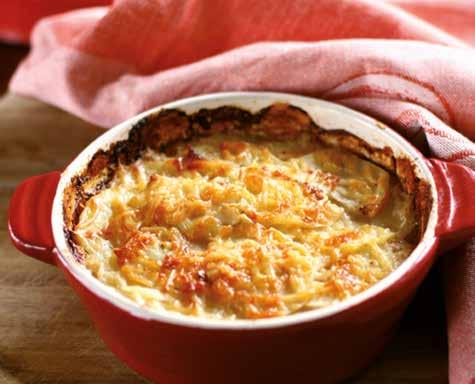
METHOD
1
2
Wash, peel and thinly slice the potatoes.
Layer the potatoes with the grated cheese in a casserole dish and sprinkle with nutmeg, salt and pepper. Start with potatoes and finish with cheese. Grate more cheddar on the top, or any other cheese.
3
Pour milk into the casserole dish to about halfway up the potatoes, adding a small carton of cream to the milk if you like.
4
5
Cover the casserole dish with foil, and bake in the oven on gas mark 3 (170ºc) for about 1 hour.
Remove the foil, turn the oven up to gas Mark 7 (22ºc) and cook for another 2030 minutes until the potatoes are soft and the topping is crisp and golden.
• Maris pipers are ideal for chips.
METHOD
1
Peel potatoes and cut into large chunks, while you pre-heat the oven to Gas Mark 7 (220ºc).
2 Pour a few tablespoons of oil onto a large baking tray or roasting dish, add the chips and use your hands to mix and coat with the oil.
3 Bake in the oven for 20-30 minutes, shaking the tray halfway through the cooking time.
4 Sprinkle with salt, or any kind of ready mixed seasoning from a jar, or just leave plain.
• 1 – 1 ½ lb (500 – 750g) turkey
• 2 onions
• 2 cloves of garlic
• 1 orange or yellow pepper
• ½ lb (250g) monkey nuts (or shelled peanuts)
• 1 pint chicken stock
• 1 tin of chopped tomatoes
• 1 tbsp tomato puree
• 1 tbsp peanut butter
• 1 tsp cayenne pepper
• Oil
METHOD
1
Warm some oil in a large, deep-sided pan and fry the chopped onions, peppers and garlic for a few minutes until just soft. Mix with the peanuts and stock and whiz the whole lot in a blender or food processor to make a rough paste.
2
Meanwhile, warm a little more oil in the pan you used to cook the vegetables. Cut the meat into chunks and brown on all sides.
3
Put the vegetable paste back in the pan and add the chopped tomatoes, tomato puree, peanut butter and cayenne pepper. Bring to the boil, stirring frequently, then turn the heat down and gently simmer the stew for about 45 minutes until the meat is tender. Serve with plain boiled rice.
Single mum Gill is the author of cookbook How To Feed Your Whole Family and a budget food champion
Q
What made you decide to write the book
A
I thought, hang on, I’ve been raising three kids by myself for years on very little money, so I thought I’d write a back to basics book full of nice, easy recipes.
Q
What would you say to people who tell you ready meals are just as cheap and easy?
A
It’s not true! I have nothing against going and getting fish and chips one night, but you can’t do it all the time. People say that Iceland ready meals are only £1 but what they forget is that you need one for every person in the family. I can buy ready-made pastry and use leftover chicken and veg and make a really simple pie that will feed everyone very cheaply.
Q And do you need expensive equipment?
A
Not at all. You see some people in the paper with industrial-style kitchens, but I do it all with just three saucepans.
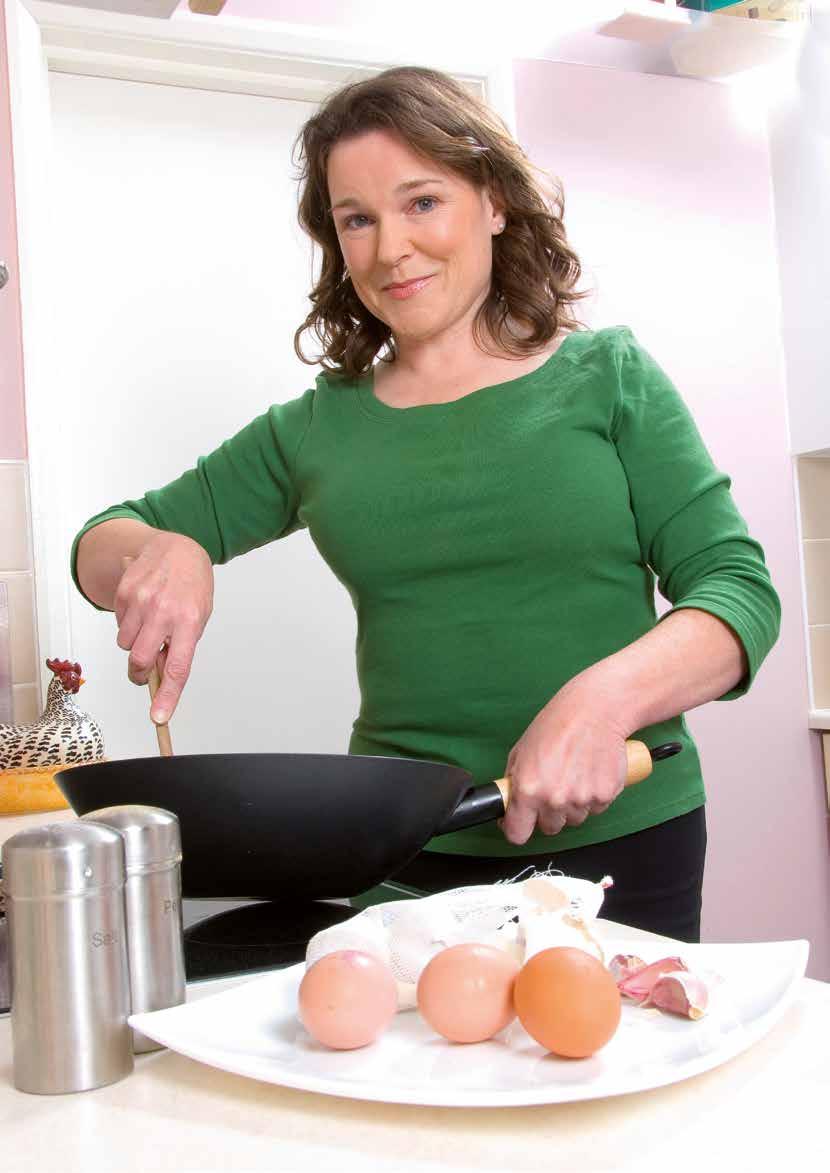
A hacking classic that makes easy work of an otherwise difficult dish, and it tastes great
• 1 packet of instant dried soup (1
½ pints approx; Knorr’s English Broccoli and Stilton soup is ideal)
• 1 packet of instant mashed potato (220g approx)
• ½ pint milk (see packet instructions)
• ½ pint water (see packet instructions)
• 2 packets x 8 Sausages
• 2 large onions
• 2 tbsp sunflower oil
• Black pepper
METHOD
1
2
Cook sausages in the usual way.
Warm the oil in a large frying pan. Peel and slice the onions then fry over a medium heat until golden.
3 Meanwhile, make the soup with milk, or a combination of milk and water, according to the packet instructions.
4
Use a fork to beat the instant mash potato straight from the packet into the cooked soup until the ‘mush’ is light and fluffy. Season with black pepper. Serve with the sausages and fried onions and frozen peas or sweetcorn.
TIP
Choose sausages with a minimum of 70% meat for maximum quality and use up uncooked sausages by squeezing the meat out of the skins and mixing with uncooked pork mince for making meatballs.
Hearty, satisfying pasta and sausage that’s also cheekily good for you
SERVES 4
• 1 medium onion (finely chopped)
• 1 clove garlic (crushed)
• 1 tablespoon olive oil
• 50g courgette (grated) 50g carrot (peeled and grated)
• 1 tin chopped tomatoes
• 2 large tablespoons tomato puree 1 vegetable stock cube
• salt and pepper (a pinch of chilli powder if wish)
• 300g pasta
• 8 pre grilled sausages (vegetarian or meat)
• 100g g cheese (cheddar or parmesan or a mixture of both)
METHOD MAKE THE SAUCE:
1
Heat the oil in a medium pan, add the garlic and chopped onion and heat on low until starts to soften, keep the heat low and add the grated courgette and carrot, continue to heat with lid on the pan until vegetables are all softened.
2 Add the tomatoes and puree, salt and pepper (and chilli) and the stock cube dissolved in 100 ml water. Leave to simmer for 15- 20 minutes until a deep red colour.
3 Chop up the cooked sausage.
• 2 tbsp oil
• 2 onions, peeled and roughly chopped
• 2 cloves garlic, peeled and roughly chopped
• 2 cm ginger, grated
• Whole or ground spices (cumin, turmeric, mild curry powder, mustard seeds), 1 tsp each
• 2 stock cubes, veg or chicken
• 500g dried red lentils
• 2 tins chopped tomatoes
• 2 tins coconut milk
• Spinach, fresh or frozen
with tomato, sausage and hidden vegetables

RECIPE COST:£3.20(80p per portion)
4 Follow the instructions on the packet to cook the pasta, drain and add to the mixture
5 Mix together the sauce, drained pasta and chopped sausage. Spoon the mixture into a medium sized oven proof dish. Cover with the grated cheese.

To change the recipe further you can also add some red pepper, some peas or kidney beans.
6 Bake in a medium oven 160C/Gas 5 for 20 minutes until the cheese is melted and golden.
Thanks to Sara for this great recipe that we love making
Sara Hayes, a food technology teacher, runs Live Learn Cook. She delivers nutrition and cookery classes in schools and local communities across Bath and Bristol.
Hannah Cameron McKenna is a food writer and recipe tester and an old friend of Quids in!
METHOD
1
In a large pan, for which you have a lid, heat the oil over a medium heat. When hot, add the onions, garlic, ginger, spices and stock cubes. Cook until soft and beginning to colour, about 10 minutes. Add the lentils, stir to combine, and add the tomatoes and coconut milk. Use the tins to top up with water, I normally add about a tin and a half.
2 Cook until lentils are falling apart, around 30 mins. Season with salt, to taste. Stir in spinach and allow to wilt/ defrost. Serve piping hot, with whatever toppings you fancy.
Optional toppings/sides:

• Toasted desiccated coconut • Boiled egg • Mango chutney • Chilli sauce • Poppadoms • Rice
Recreate that classic sweet and sour taste
SERVES: 4 WITH NOODLES OR RICE
• 1 tbsp veg oil
• 1 garlic clove, crushed
• 2 chicken/turkey breasts cut into bitesized pieces OR a block of firm tofu and 4 handfuls cashews
• 3 tbps low salt soy sauce
• 1 pepper
• 2 carrots
• 1 tbsp corn flour
• Freshly ground black pepper
• Half a bag bean sprouts OR a bunch of spring onions
• 227g tin pineapple chunks in juice
METHOD
1
Prepare the ingredients –Peel carrots and pepper. Cut into thin strips –Trim spring onions and slice (if using) –Open and drain the pineapple (save the juice!)
–If using tofu, drain, dry with paper towel and cut into bite-size cubes
2 Heat the oil in a frying pan. Add the chicken /turkey and garlic. Cook over a medium heat for 5 minutes
• 140g butter, softened, plus extra for the tin
• 140g caster sugar
• 2 large eggs, beaten
• 140g self-raising flour
• 1 tsp baking powder
• 2 over-ripe bananas, mashed

3
Add the carrots to the pan and cook for 5 more minutes. Add the pepper and the pineapple chunks, stir for 2-3 minutes
4 Add water to the pineapple juice to make it up to 200ml. Mix well and pur in the pan.
5 Put the corn flour into a cup, add the soy sauce, mix and immediately add to the pan along with the spring onion or bean sprouts. Bring to a simmer and cook for 2 minutes. Add black pepper to taste and cashews if using.
We got this recipe from an amazing local course…
Cook It is a free cookery course for parents and their children. Run by the Virgin Care Wellbeing Service in Bath, the five-week course normally takes place in community venues. The course gives parents the opportunity to cook tried and tested budget friendly recipes at home with their children. Participants receive a weekly phone call from a friendly voice to discuss healthy eating topics and choose recipes.
Cook It is free and once the course is completed, families receive a free recipe booklet and a £25 supermarket voucher. Why not ask your landlord or local health care provider if there are similar courses near you?
This one works well in kid’s packed lunches (see page 23)
METHOD
1
2
Heat your oven to 180C/160C fan/gas 4.
Butter a loaf tin and line the base and sides with baking paper.
3 Mix the butter and caster sugar together until it is light and fluffy. Slowly add the beaten egg mix. Gradually add the flour, bit by bit, continuing to stir as you go.

4 Then add the baking powder and mashed bananas.
5 Pour the mixture into the tin. Bake in the oven for about 50 minutes. Check the loaf is cooked by testing it with a knife (if the knife is removed cleanly this means it’s done)
6 Leave to cool in the tin for 10 minutes, then remove it onto a wire rack or plate.
7 Mix the icing sugar with 2-3 tsp of water to make a quick icing.
8 Drizzle the icing across the top of the cake and enjoy!
Vibrant, delicious Chicken Tikka Masala exactly the way a takeaway makes it
• 2 tbsp coriander seeds
• 2 tbsp paprika
• 2 tbsp jeera
• 1 tsp mango powder
• 1 tsp chilli powder
• Juice of one lime
• 10 tsp good thick yoghurt
• Salt to taste
• 2 lb chicken, diced
• 5 to 6 cloves garlic, chopped
• Chicken stock or water
• Oil
METHOD


1 Grind the spices and mix with yoghurt to make the marinade.
2 Marinade chicken in fridge for 24 hours.
• 200 g paneer
• 2 tbsp plain flour or corn flour
• Oil for frying
• Onion, chopped
• Garlic, chopped
• Green chilli, chopped
• Tomatoes, tinned or fresh
• Double cream
• Garam masala
• 2 tsp coriander powder
• Turmeric
• Salt
• Coconut for garnishing
• Fresh coriander
• 1 tsp sugar
METHOD
1 Take paneer, add flour, chopped chilli and salt according to taste and mix to make a dough.
2 Make about 10-15 small balls from the dough and deep fry on medium heat.
3 Heat the oil in frying pan or wok until very hot.
4
5
6
Stir fry chicken vigorously for about 5 mins.
Take out chicken and keep warm.
Fry the onion and garlic until just browning and return chicken with any remaining marinade, plus the stock, plus
In 2008, the community of Totterdown in Bristol got together and published their own recipe book. Here are a few of our favourites…
© Taste Of Totterdown
more spices if you think the sauce needs it – an extra tsp of cumin and coriander may ‘lift’ it a little.
7
Simmer until the chicken is cooked and the sauce is nice and thick. Serve.
Recipe supplied by Best Spice, Wells Road, Totterdown.
3
Stir fry chopped onion until light brown and add chopped tomatoes, 1tbsp tomato puree, garlic, chilli, salt, turmeric.
4 Stir well and add ½ cup of water, 1tsp sugar, garam masala and mix.
5 Add double cream, mix well and add paneer fried balls and cook for 2 mins.
6 Garnish with coconut and fresh coriander and serve with nan, partha or chipatti and basmati rice.
PANNA’S TOP SPICE TIPS
• For very spicy curry use milk to mild it down and stir well.
• Use mustard seed. Put in hot oil first and let it pop.
• Use garlic in cooking, chopped and fry it in oil until golden brown.
• Use cumin seed. Fry in hot oil.
• Cook with garam masala, add just before your dish is ready for good flavour.
• Don’t use too much onion in curry, it can upset your stomach.
• If curry is very thin add some double cream.
• Instead of curry powder add all the different spices to your curry to find a better taste.
• Add fresh coriander just before serving food.
• If you need any top tips for cooking curries, Panna from Patco will help you!
Recipe supplied by Panna Patel from Patco, Wells Road, Totterdown.

Simple, gorgeous food
SERVES 4
• 1 cup of water
• ½ cup sunflower oil
• 8 chicken thighs, skinned
• 1 chopped onion
• 3 cloves garlic, crushed
• 2 tsp salt
• 1 tsp chilli powder
• 1 tbsp garam masala
• 2 tbsp of demerara sugar
METHOD
1 Add the chopped onions to the heated sunflower oil and brown.
2 Add the chicken thighs and brown demerara sugar.
3 Once sugar is melted and the chicken is browning, add the remaining ingredients.
4
Add 1 cup of water and simmer for 30 mins.
5 Garnish with chopped coriander and fresh green chillies.
Recipe supplied by Vishnu.

• Scallions – bunch of big spring onions
• 2 large onions
• Fresh thyme
• 1-2 tins ackee – you can find it in West Indian shops
• Rice
• Scotch bonnet/chilli – be careful!
• 4 large tomatoes, quartered
• Cod
• Black pepper and salt to season
• Corn oil (or butter or olive oil)
METHOD
1
Soak the cod for 24 hours in cold water to dilute the salt or boil to get rid of the salt. If cod has skin, de-bone or remove skin to taste.
2
Sweat onions in corn oil, olive oil or butter.
3 Add seasoning and tomatoes.
4
Add cod to the rest of the ingredients.
5

Spicey and nicey — the West Indies classic
Add ackee (1-2 tins) and heat thoroughly. Be careful not to stir too much to avoid breaking the ackee.
6 Serve with plain rice, or alternatively rice and peas, plantain, yam or boiled dumplings.

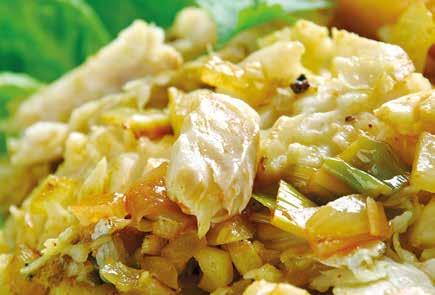

These are absolutely delicious, and great to grab-and-go. I love to do a double batch as they freeze really well and can be defrosted overnight in the fridge. That way, I always have them at the ready for those rushed school mornings!
Serves 4
• 2 large bananas
• 80g porridge oats
• 50g chopped up chocolate, chocolate chips or raisins (or a combination of chocolate and raisins)

METHOD
1
Preheat the oven to 180°C/Fan 160°C/ Gas 4 and line a baking tray, ready for your cookies.
2 Mash the bananas really well in a large bowl. Add the oats and mix together.
3 Stir through the chocolate or raisins (or both if you love a chocolate-raisin combo).
4
Scoop out eight dollops of the mixture, placing them on the baking tray, evenly spaced.
5 Bake for 10–12 minutes until golden brown, then cool on a wire rack.
This recipe introduces you to my legendary cheese sauce. Some people are wary of a white or cheese sauce as it takes time, but it’s worth it as you can make a large vat of the white sauce and keep it in individual portions in freezer bags. Trust me, once you’ve made this you won’t ever go back to pricey jar or packet sauces.
Serves 4 plus 4 leftover portions
• 300g pasta
• 400g frozen mixed veg
• 1l white base sauce (See page 12)
• 200g cheese, grated
METHOD
1
Bring a large saucepan of water to the boil and cook the pasta according to the packet instructions. Cook the veg in the same pan, a few minutes before the pasta is done.
2
Make your white base sauce or, if you’re like me and keep reserves of it ready for any occasion, retrieve some from the

freezer and heat it gently to defrost.
3 When the white sauce is ready stir in half the cheese and let it melt.
4 Once the pasta and veg are ready, take out 1 ladle of the cooking water and add it to the cheese sauce, stirring through.
5 Drain the pasta and veg and put into a large dish.
6 Pour over the cheese sauce and mix well.
7 Top with remaining cheese and put under the grill to melt for 5–10 minutes. TIPS
Add some cooked gammon or chicken for an extra flavour boost.
Scottish food champion Lorna runs the amazing ‘Feed Your Family For £20 a Week’ website
We’ve got 5 copies of Lorna’s book to give away. Just visit qimag.uk/lornacooper for details on how you can be entered into the prize draw.

Hi Jack, what inspired you to cook, and then to blog about it?
I’ve cooked for years, I left home in my late teens and started to teach myself to cook and I suppose it just grew from there.
You’ve spoken about your struggles as a lone parent on benefits… at your lowest point, what was your worry?
Losing my home and losing my son. I managed to keep my head just above water – keep myself fed, clothed, clean, happy and we’ve done alright. But that was my biggest fear and it’s a really dark fear and it just gnaws away at you as well.
Did you borrow money?
No. I was offered pay day loans left, right and centre. I don’t know where these people get your details from but I had letters dropping through my door several times a week. They said, ‘We know you need a bit of money, do you want some?’ I was like, ‘No, I don’t.’ Because even at my most desperate point I couldn’t borrow money that I knew I wouldn’t be able to repay.
According to our survey 1 in 12 of our readers has used a food bank – does this surprise you? No, several of my friends are food bank users and I think the fact that it is becoming so normal is a terrifying indictment of the state this country is in.
What’s your favourite food?
I really love food, it’s really hard for me to just pick one, but I think it’s got to be peanut butter. Peanut butter is one of those things that I could eat a few tablespoons of and call it a meal, because I’m just like ‘I love peanut butter’.
Have you got any tips for our readers on savvy shopping?
Make a list before you leave the house of what you’ve got already. I’m a bit obsessive and sort my list into proteins, carbs, fruit and veg, and dairy products. So I see what I’ve already got and then buy things only where I need them.
Visit cookingonabootstrap. com for Jack’s recipes and our website for more from Jack

“My main worry was losing my home and losing my son”
“This chilli is adapted from a beef chilli recipe by Gordon Ramsay. I simply left out the beef and halved the wine to make it cheaper – plus, of course, Mr Ramsay doesn’t use a tin of cheap baked beans in his version! I’ve tweaked and fiddled with it so much over the years that now it’s not Gordon’s chilli, it’s Mumma Jack’s.” Serves 4
• 1 x 400g tin of red kidney beans
• 1 x 400g tin of baked beans in tomato sauce or plain haricot beans
• 1 onion
• 1 small chilli, chopped
• a shake of paprika
• a shake of ground cumin
• a splash of oil
• 75ml red table wine
• 1 x 400g carton or tin of chopped tomatoes
• 1 vegetable stock cube
• 3 squares dark chocolate

METHOD
1 Tip both tins of beans into a colander and rinse thoroughly. If you are using baked beans in tomato sauce, make sure to rinse it all off. Pop the beans into a saucepan, cover with water and bring to the boil. Boil rapidly for 10 minutes, then reduce to a gentle simmer.
2 Peel and dice the onion and put into a large sauté pan along with the chopped chilli, paprika and cumin. Add the oil and cook on a low heat until the onion softens into a spicy sweetness. Pour in the wine, add the chopped tomatoes

and crumble in the stock cube, then simmer all together on a low heat.
3 When the beans have softened, drain and tip into the sauce. Add the chocolate and stir until the beans are mixed through and the chocolate is melted.
TIPS: This chilli will keep in the fridge for up to 3 days if allowed to cool and stored in an airtight container. Delicious eaten cold stuffed in pitta breads or wraps for next day’s lunch.
There’s been a lot of talk recently about ultra-processed foods and the harm they’re doing to our health. It’s not just a case of causing us to pile on the pounds. There’s a lot of research that’s showing these foods can also make us more likely to develop diabetes, heart disease and even depression and cancer.
The lack of nutrients can also harm our gut health, which might leave us feeling a bit below par even if we don’t have a chronic condition.
But the problem is that so many of us just love these foods. No one more so than TV medic Dr Chris van Tulleken, who even described his relationship with certain ultra-processed foods as “addicted”.
But then he started looking into these products, how they were developed and why he was eating too much of them.
What he found was that for food companies to make money, they had to design products that made us eat more than we needed. He gives the example of a cereal company that puts two versions of its product out to testers. If one version makes people eat five per cent more then that’s the version that ends up on the supermarket shelf.
We keep hearing how bad ultra-processed foods are for us – but can we avoid them without spending more?
“So consumers are hammering the supermarkets down, the supermarkets hammer the producers, so we end up with the root problem being poverty and inequality.”
Why? Because in order to make money from their products, the food companies need us to buy more of them than we really need.
And often ultra-processed foods are quite cheap. But because they’ve been engineered to be easy to chew and swallow, we tend to eat more of them without realising. That means, of course, that we buy more.
It’s not our fault though, says Dr Chris. Because ultra-processed foods have been developed in a lab rather than cooked up in our kitchen at home, a lot of thought (and science) has gone into making sure we can’t resist.
The foods have also been modified to extend their shelf life, meaning of course that we’ll end up throwing less food away.
‘The number one thing customers want is cheap food’
But there’s more to the problem than that. It’s about the cost of living too.
“The number one thing customers want is cheap food,” Dr Chris told the Penguin podcast. “We live in such an unequal society. Everything is so expensive: our transport, our energy, our accommodation. We’re paying so much on rent, there’s nothing left for food.

Dr Chris loved treats but wanted to know what they were doing to him
That’s always a plus when we’re living on a tight budget.
But what we didn’t know until recently was how sick eating a diet heavy in these foods can make us over the long term.
Researchers have found that a homemade pizza is much less harmful to our health than an ultraprocessed version from the supermarket.
And that’s even if we add lots of salt and extra cheese to the homemade one!
So that’s the bad news. The good news is that it is possible to cut back on ultra-processed foods on a tight budget.

What’s an ultra- processed food?
Dr Chris has a pretty simple rule of thumb for this. If we check the ingredient list and there’s something on it that we wouldn’t find in our kitchen at home, then it’s probably ultra- processed.
Lots of these ingredients have long, chemical-sounding names and they might be there to influence the texture, the shelf life or simply because they’re cheaper than “real” ingredients.
But they’re certainly not in there for our health! Some examples of ultra- processed foods include fast foods, frozen meals like pizzas and chicken nuggets, breakfast cereals, ready meals and packaged biscuits and snacks.
A day out can become expensive, even if you are just going to the local park. And if you’re walking it’s not long before tummies rumble and the kids start to grumble
Constant demands for snacks and drinks can end up costing us the earth. Taking a packed lunch along works out cheaper and healthier. It might feel like the boring option but we’ve got some tried and tested tips which will liven it up, keeping the kids happy and the cost down.
1 Make their favourite food
Make your child’s favourite sandwich, so they are more likely to eat it! Include healthy, easy-to-carry snacks like bananas, apples, or home-wrapped mini packs of raisins (from a cheaper, big bag). Hunger-busting flapjacks are also a winner, (see our super easy recipe below). Invest in a solid, re-usable lunch box. If you have a freezer, a freezer block will keep food chilled.

2 Take re-usable bottles of water or drinks. They’re better for the environment and keeps costs down as they’re so dear to buy out.
3 If you have foods that are past their best, use them to prepare some treats for when you are out. Over-ripe bananas can be used to make a banana loaf (see page 17). Other fruits past their prime can be used to make smoothies.
4 Encourage the kids to help you prepare the packed lunch. Research (and our own experience) shows that, if they feel they have helped to make it, they are much more likely to eat it!
5 If you avoid spending on treats all day, it’s not so bad if you cave in to demands for ice creams. (Don’t forget, though, it’s still cheaper to pop into a supermarket and buy a box of lollies or choc ices!)

All you need to make these yummy flapjacks are four ingredients. They’re also super quick and ready in halfan-hour. If you have any dried fruit lying around like raisins or apricots, add those in for a fruity kick. Nuts work really well too - try hazelnuts or peanuts (unsalted).
(Makes 12 individual slices)
INGREDIENTS
• 250g porridge oats
• 125g unsalted butter
• 125g light brown sugar
• 2-3 tbsp golden syrup
METHOD
1 Heat your oven to 180C/160C fan/ gas 4.
2 Put the butter, sugar and golden syrup into a saucepan and put on a low heat until all the ingredients have melted.
3 Pour in the oats and stir the mixture so that it is combined.
4 Lightly grease a baking/roasting tin with a knob of butter and spoon in the mixture. Press into the corners with the back of a spoon so the mixture is flat.
5 Then bake for around 30 minutes until golden brown.
6 Leave to cool completely then cut into 12 slices.
If you qualify for free school meals, make sure your school is getting the Pupil Premium
Mmany of us aren’t receiving the benefits we are entitled to – and that's particularly true when it comes to our kids.
The Pupil Premium was introduced by the government in 2011. It is an extra benefit for children that receive free school meals, and it's often not claimed. Here’s everything you need to know about the scheme and how to apply for it.
Schools receive a sum of money for each pupil, and put it towards ways of improving their performance in class.
Quids in! says it all the time, but still many of us aren’t receiving the benefits we are entitled to. The Children’s Society estimates that one million children are missing out on free school meals and are going hungry.
If we receive Universal Credit, (and provided we have a net income of £7,400 or less), or Income Support or Income-based Jobseekers’ Allowance, then our children will be eligible for free school meals. Also,


“I love school dinners, roast dinner is my favourite”
children who are or have been in care, and children who have a parent who is or was in the armed forces, are entitled to Pupil Premium.
If we’re on benefits, getting free school meals can open up other help including possible uniform grants, which has a similar application process.
Some areas in the UK have already rolled out ‘universal free school meals’. Here, all children, up to a certain age, get a free meal whatever their parents’ income. If this is the case, your child’s school will have informed you.
Remember! If our children have qualified for free school meals on the above grounds in the past, but are no longer eligible, schools still receive the Premium for another six years.
Visit our website to make sure you qualify www.quidsinmagazine.com/free-schoolmeals/
It is up to the school to decide how they spend their Pupil Premium money. It is usually put towards one-to-one support within the classroom, employing extra
teaching assistants, running a breakfast club, family therapy sessions or funding school trips. Some schools use the funding to help out individual pupils, by doing things like buying them a PE kit or tablet.
We could also qualify for Healthy Start Vouchers (if we're on benefits, are pregnant and under 18, or have children under the age of 4). The vouchers can be spent on milk, fresh, frozen, and tinned fruit and vegetables, fresh, dried, and tinned pulses, and infant formula milk. We can also get free vitamins. To check if we qualify visit www.healthystart.nhs.uk
THINK YOU ARE ENTITLED TO FREE SCHOOL MEALS AND THE PUPIL PREMIUM?
Get in touch with your Local Authority and your school, to be registered. More on free school meals (and help with other costs like uniforms or school trips) qimag.uk/pupilpremium

ugh Fearnley-Whittingstall is used to a good fight. But he admits that the challenge of taking on food waste is an even bigger one.
But it’s not just the pennies we’d be saving if we could cut back on the waste. It takes a lot of fresh water to raise crops and rear livestock – all wasted when we bin the goods. About 45 trillion gallons of fresh water is wasted this way. To get it from the ground to the shops takes a lot of haulage,
usually meaning heavy trucks guzzling plenty of fuel. But then, as wasted food rots, it releases methane, a greenhouse gas adding to global warming. In a similar vein, when farmed produce uses space that could be woodland breathing life back into the air. Add to that, our leftovers are polluting 900 million hectares around the world.
We throw away a whopping seven million tonnes of food and drink every year, and more than half of this is food and drink we could have eaten. This costs the average
1
A lot of fresh produce (sadly) comes in plastic bags at the supermarket, particularly salad, herbs, carrots and parsnips. They are best kept in the packaging until you want to use them.
2
Mushrooms will sweat and rot if left in plastic so transfer them to the fridge in a paper or cloth bag.
3
Potatoes should not be kept in plastic either. Store your spuds in paper, cloth or netting, in a dark, cool place, but not the fridge.
4
If you’ve used half a bunch of herbs, trim the stems of the rest, put in a jug of water and store in a cool place or the fridge.
5
If your salad or spinach leaf is a bit limp dunk it in a bowl of iced water for a few minutes and it will be magically revived.
6
Don’t bin the skins! Potato, beetroot, parsnips and carrot peelings can be turned into delicious veggie crisps. Make sure they’re clean (it’s easiest to scrub them well before peeling!) then toss with oil, season and roast on a baking tray for about 12 minutes at 200C/gas 6.
7
Preserve ripe bananas by keeping them in the fridge. The skins will blacken but
Quids in! joins the campaign to cut down on food waste, saving our world and our pennies
household £470 a year, rising to £700 for a family with children. That’s pretty much £60 a month.
“We’ve lost the sense of responsibility for our actions, and of trusting our own resources, our nose and our common sense,’ says Hugh, adding: “Use-by sounds like an order. It makes people think that at midnight on the 29th, something’s going to go from a perfectly safe food to a deadly poison. Of course, it isn’t like that.”

8
Softening berries can be crushed, (and sieved if they’re pippy), then combined with honey and yoghurt, poured into lolly moulds and frozen for a healthy treat.
9

Found yourself with strawberries just past fresh? Make ‘raw jam’ by slicing them, squeezing over some lemon juice and sprinkling on some sugar. Leave for half an hour or so and the juices will form a delicious syrup on the fruit.
10
Freeze hard cheese! In fact, freeze any dairy product that’s going out of date (except soft cheese). Butter, cream, milk and hard cheese can all be frozen then defrosted and used as normal.

≠ Join the Twitter campaign. Search #wastenot
If you are struggling with money, debt or housing related problems, don’t suffer in silence. There are loads of organisations offering free and helpful advice. We’ve rounded up the main ones who should be able to help (or point you in the right direction)
Different departments at our local council may be able to help us stretch our budgets in different ways. If they can, we’ll free up much-needed cash for meals:
• The team that deals with Housing Benefit and Council Tax, (sometimes called often ‘Revenues and Benefits’), can advise if there’s any help we can claim
• If we’re facing real hardship, we can explain to the housing team and ask if we might qualify for a ‘Discretionary Housing Payment’ for help with rent, deposits and arrears
• Their welfare (or employment) team can provide guidance on grants, benefits or who to speak to about help finding work
• Most councils currently have a Community Hub that can help ensure we have access to food, advice and support
Look up the council website and search for each of these teams for contact details.
LOAN SHARKS
The Illegal Money Lending Team tackles loan sharks. Call anonymously on ✆ 0300 555 2222, text LOAN SHARK and your details to 60003 or email them at reportaloanshark @stoploansharks.gov.uk. In Wales call ✆ 0300 123 3311 or email imlu@cardiff.gov.uk Scotland: ✆ 0141 2876 655, or email loansharks@glasgow.gov.uk
CREDIT UNIONS
Credit unions are not-for-profit organisations that provide bank accounts, loans and savings. They may help people the banks won’t. To find your local credit union call ✆ 0161 832 3694 or visit www.findyourcreditunion.co.uk.
BENEFITS
• People with disabilities or carers should contact the Disability Benefits Centre (✆ 0345 605 6055) . For Child Benefit/ tax credits: Inland Revenue (✆ 0845 300 3900).
• Council Tax and Housing Benefit is dealt

with by your local council.
• Benefits calculator qimag.uk/benecalc
• Pensions Service: ✆ 0800 99 12340
• Age Cymru Advice ✆ 0300 303 44 98
• Age Scotland Helpline ✆ 0800 12 44 222
• Age UK England ✆ 0800 678 1602
For free debt advice and help, contact any of the organisations below.
• National Debtline ✆ 0808 808 4000 www.nationaldebtline.org
• StepChange Debt Charity ✆ 0800 138 1111 www.stepchange.org
• Citizens Advice www.citizensadvice.org.uk.
In Wales call ✆ 08444 77 20 20 England call ✆ 08444 111 444
• Citizens Advice Scotland www.cas.org.uk. ✆ 0808 800 9060
• Debt Arrangement Scheme (Scotland) www.dasscotland.gov.uk
✆ 0300 200 2770
For pantries and other options check your local council website, or Feeding Britain: www.feedingbritain.org
Quids in! is the money skills programme from Clean Slate Training & Employment, a not-for-profit helping people become better off. Do you live near one of our ‘Quids In Centres’? (See outside back cover of this guide.) If so, we’ll walk you through a money health-check to help you stretch and grow your budget. If not, take the EASY 25 YES/NO QUESTIONS Quiz on the Quids in! website at qimag.uk/quiz.
To find your nearest food bank ask a local advice agency or your council. You can also search via the postcode map on the Trussell Trust website: https://www.trusselltrust.org/gethelp/find-a-foodbank/
• You can find other, independent food banks through the Independent Food Aid Network (IFAN): foodaidnetwork.org.uk
• Sufra sufra-nwlondon.org.uk provides refugee support, a food bank, community kitchen and more. Check out their website for details.
If your landlord is the council or a housing association, they should be supportive. Landlords can get tough with people who don’t keep on top of their rent but if you have a good relationship with them, they will try to keep the pressure off while you work things through.
We don't just have to sit back and let bad things happen to us, it can feel really great to be a part of the solution too… Here are some ideas to inspire us into action!
Our food system doesn’t work as well as we need it to. Recent reports show that we are relying on food banks more than ever. But, with donations down, food banks are struggling too with some struggling to get enough food to meet the demand.
To help ease the pressure on food banks, other models of getting access to food have developed and grown over the last few years.. What they all have in common is creating better access to quality food, fighting waste and helping to build a community. Here’s how they work…
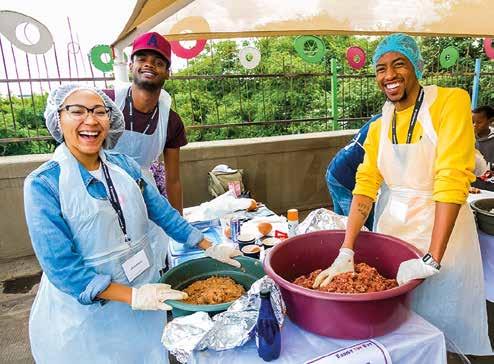
The Long Table, based in Stroud, Gloucestershire is a community kitchen which serves chef cooked food that would otherwise have been binned. Wonky veg or surplus meat won’t go to waste here.
At the Long Table, food is served to customers and staff twice a day throughout the week.
They also host a cookery school and believe the project is more than just providing a healthy meal. It’s about people learning to cook healthy food for

themselves, building community, looking after the environment and creating employment.
The business operates on a ‘pay what you can’ basis. Everybody receives a meal and becomes a customer. This creates the feel of being part of something bigger which Long Table's Will Mansell believes is important to our mental health and wellbeing. “Eating together as a collective reduces the feeling of isolation,” he says. “We’re much better off living in a community than as individuals.”
Meanwhile, food clubs and pantries are popping up all over the UK.
Food Clubs are normally found in children’s centres. We will typically pay an annual £1 membership fee and weekly payments of £3.50 which gets us approximately £15-£20 worth of food. Members will have access to a support network and cookery lessons.
Pantries are located in churches and community centres. They work on a local membership model too. We pay a couple of quid per visit and are entitled to a basket of groceries worth up to five times more. Pantries work in partnership with the charity FareShare and local wholesalers, who provide surplus food and other items.
In South Kensington, London’s wealthiest borough, people are struggling to buy good quality food.
“Need in South Ken is very hidden,” says Alice Webster, community investment manager at Southern Housing Group, and the driving force behind the Ixworth food pantry.
Ixworth Place estate is one of the largest in the borough, with over 250 homes. A dilapidated storage
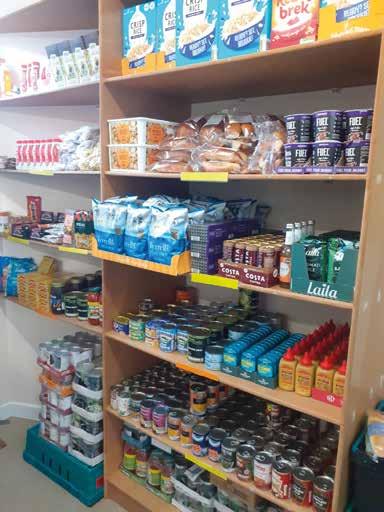
room on the estate was turned into a pantry. The pantry is open three days a week and has over 100 members. Food is labelled in a traffic light system (red, amber, green), relating to availability and stock.
The quality and variety of food is what makes the pantry so special. One week there was a surplus of sirloin steaks, another week it was

pumpkins.
The pantry has connected neighbours, “This type of model tackles the issue of self-isolation and that is so important in today’s world,” says Alice.
¬ To find your nearest local pantry, check on the map here www. yourlocalpantry.co.uk/find-apantry/?page=2
Citizens’ Supermarkets are large facilities which have a community cafe and advice hub. Some have cookery and IT classes on-site, as well as second hand furniture shops. Usually we are referred by our housing provider, agency or we can self refer. Some supermarkets have a pay-peritem system at the checkout while others ask for a flat fee in return for a range of items. Food is heavily discounted, using surplus stocks from retailers and manufacturers.
You can find citizens supermarkets

in Birkenhead, Coventry and Bradford. There are plans for new openings in Glasgow, Norwich, and Sheffield too.
In some parts of the UK there are ‘mobile’ citizens’ supermarkets –that's a double decker bus kitted out with a shopping area, advice booth and cafe.
A food bank is a storehouse for millions of pounds of food and other products that are donated by the public. Volunteers sort the food into parcels. In times of emergency, health visitors, schools or social workers can give us a voucher which entitles us to a food bank parcel worth three days of food. The Trussell Trust is the largest food bank network in the UK with over 1,200 food bank centres.

A Community Fridge is a space where anyone can share food to avoid food waste, either by bringing food to leave in the fridge or by taking food from the fridge to use themselves. They are welcoming spaces open to all. As friendly community spaces, we have a few ways to be involved:
• We can use the fridges. Find your nearest fridge and collect free food that would otherwise go to waste.
Here, we can pay for food at a heavily reduced rate - it can be as low as 30p for every £1 you would spend in a normal supermarket. They know their customer base and who needs that bit of extra help. Social supermarkets aim to be completely sustainable and use local suppliers.
• We can donate food. If you’re a retailer, café, restaurant, or business with left over food, you can donate it to community fridges. Even if you just have food at home that you won’t eat, you can donate that too!
• We can volunteer our time.
The success of the Community Fridge Network is down to the amazing volunteers who make it tick. Find your local fridge on the website map and contact them directly to see
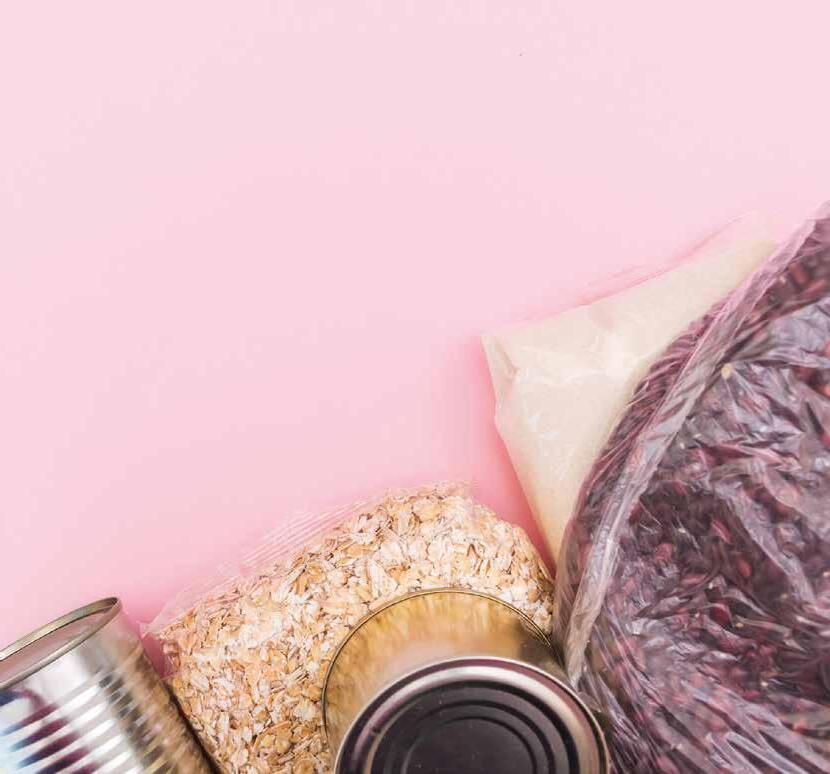
if they are looking for extra help.
And if we don’t have one near us but think it’s a cool idea there is a guide on their website on how to set one up. Check out where in the UK to find your nearest community fridge by looking up communityfridgemap.org.uk/ directory
They say money doesn’t grow on trees but savings do – and on bushes –and in the ground – if we grow our own fruit and veg. With people struggling to keep food on the table, harvesting our own means eating something fresh and free
Growing our own veggies is back in vogue. Having an allotment is one way to go, but even without a plot of land, there are other money-saving hacks to put free food on your plate.
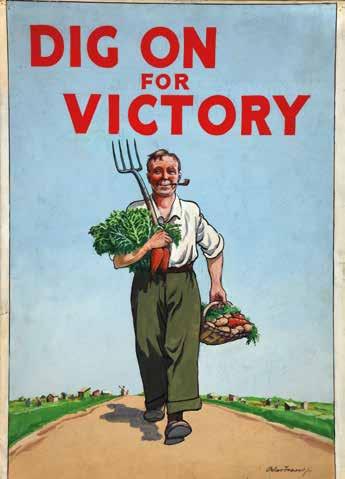
75
years on and still relevant to the war on hunger

There are around 300,000 allotment plots in the UK, and another 100,000 people on the waiting list. At one point, during the second world war, there was an estimated 1.4 million plots. With food prices going up, there’s never been a better time to grow your own…
Most of us don’t have our own allotment and the waiting lists are long. But that doesn’t have to stop us growing our own. A single bed in a garden can be used, and we can even grow our own in a window box. Lettuce, spinach, radishes and even carrots can be grown in a window box.
More community gardens are also cropping up where fruit and veg is often grown. The social farms and gardens website lists these all over the UK, (see findafarm
We can set up our own community garden.

The voluntary action group NCVO has a how-to guide to all the steps needed to do exactly that. It includes everything from finding the land and what we’d need on-site, to finding a grant to get us started. Visit qimag.uk/plotyourpath
There are loads of health benefits of growing our own fruit and veg. Gardening is physical, and all that digging and planting, weeding and watering gives us a healthy workout. People have even argued that gardening should be offered on the NHS. (Yes, really!)
“The average plot yields £1,362 of fruit and veg a year.”

Dr William Bird, an NHS GP, told the Royal Horticultural Society: “We could see benefits of at least £5 health benefit for every £1 spent. Since about £60 billion is spent on long term conditions, 80% of which could be prevented by a healthier lifestyle, there is a significant incentive to develop a programme that includes horticulture.”
That’s not all, the mental health charity MIND ran a project called ‘Eco Therapy’ where people spent time
gardening and growing to try and help their mental health. Seven out of 10 of the people involved said the programme gave them a ‘significant increase’ in wellbeing. Of the unemployed people involved, 254 got back into full-time employment afterwards.
Is it really cheaper to grow your own fruit and veg? Which? Magazine found that for things that are expensive in the shops, like soft fruit, (raspberries, strawberries, tomatoes, etc), yes, it’s cheaper.
The average allotment plot is 250 square meters. The National Society of Allotment and Leisure Gardeners say the average plot yields £1,362 of fruit and veg a year. It’s a chance to make a few quid too. For smaller plots, like a garden bed of two square meters, we’ll only get enough veg for a couple of meals a week. But, as they say, every little helps.
But there are still some types of veg that we can save money growing that are also easy to cultivate. As Sarah Brown, spokesperson for the charity Garden Organic told moneywise magazine recently: “Runner beans are a great money saver,” she said, with a packet of twenty-five beans costing £1, enough to grow about four kilos of fresh runners. Asparagus plants, too, she explained, cost 75p per crown and can last up to twentyfive years in a well prepared bed!
Gas and electric costs are criminal and with the kettle, for one, being a repeat offender, it’s time to lay down the law. For over 13 years, Quids In! readers have shared their top tips to beat the bills. How are we gonna eat, if everything goes out on what it takes to run a home?
10DRY your laundry outside instead of using the tumble dryer
11DON’T dry clothes on radiators. It makes your boiler work harder
12KEEP filters clean in your tumble dryer, if you have no choice but to use one

Only fill the kettle with as watermuch as you actually need
1SAVE power by putting lids on saucepans when cooking and use the right size of cooking ring for your pan
13HANG or fold clothes up after drying them so they will need less ironing. If you’re going to iron, they iron more easily when still slightly damp

Limit
2ONLY fill the kettle with as much water as you actually need. (It can cost 12p a time to boil a full one, so not long before we’re saving pounds). Same with boiling vegetables on the hob – only use just enough water to keep your veggies covered
3AVOID putting hot food in a fridge or a freezer. Let it cool first
4KEEP your fridge at around 3°C to 5°C and save electricity by regularly defrosting your freezer
5DON’T leave the fridge or freezer door open longer than you need. Move them away from cookers and direct sunlight where possible
6WHEN replacing electrical goods look for an ‘A’ energy rating. Buy only the size you need
7USE a full load in a washing machine. Half loads waste energy. (Even an A-rated machine costs 27p per wash)
8CHOOSE an economy programme on your washing machine whenever possible
9WASH your clothes on a lower heat. Most detergents now work well at 30°C or even 20°C
14ENERGY saving light bulbs last up to 10 times longer and cost less to run. And of course, remember to turn off the lights when not in use
15UNPLUG your mobile phone or games console from the socket when it has charged
16SWITCH appliances (including your TV) off standby
17SIZE does matter. The smaller the TV, (like most electrical items), the cheaper they are to run
18NEVER leave taps running, or even dripping
19LIMIT wash times in the shower to save water (to help the environment) and usage of the boiler (to save on cost). Ten minutes in an electric shower can cost 44p or more
20AVOID heating an empty home. Set the heating to come on 30 minutes before getting up or arriving home. Likewise, have it switch off 30 minutes before going to bed or leaving for work
21 TURN your heating down by 1°C, this can cut your energy use by 10 per cent
22KEEP your radiators clear, don’t put anything in front or on top of them
23CONSIDER putting radiator panels behind radiators fixed to external walls
24BLOCK all draughts around the house to stop heat from escaping and use heavy curtains during the winter. Keep them drawn after dark
25IS your water too hot? Your boiler thermostat should be set at 60C°
Smart meters can help us watch what we’re spending. Literally. They display the usage and the cost as we turn things on.
[Costs are just a guide. See: www.confusedaboutenergy.co.uk]

Your boiler shouldthermostat be set at 60°C


The Future-Proof Finance Quiz is online and open to anyone anywhere. Try it out. Can you boost the health of the cash in your pocket? It asks simple yes/no questions and nothing too personal. Based on your answers, it guides you through your next steps towards being better off. Visit: qimag.uk/quiz

Are you near one of our Quids In Centres?
Do you live in London, Bristol, Bath and North East Somerset or Gloucestershire, or are you a Stone water tenant? If so, come and see us! We can walk you through the Quiz and help you choose the best ways to give your finances a lift.
Visit here to find exact locations and times www.cleanslateltd.co.uk/contact or ‘Sign Up’ and a member of our team will be in touch. We are also running workshops - take a look at our website for more details.
